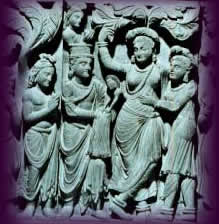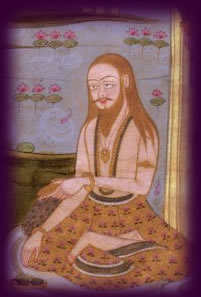
Birth
of the Buddha
(2nd cent CE
stone relief)
It is said that the future Buddha himself chose his parents prior to his immaculate conception. His birth took place in a garden, with his mother, Queen Maya, clasping a tree as the infant emerged from her side.
One of the major festivals in Buddhism is Wesak, which takes its name from the month in which the person known as the Buddha (‘awakened one’) was born; Buddhists in the Theravadin tradition also use this occasion to honour his enlightenment and his final passing into nirvana.†
Buddhism is significant in that it is the one major world religion whose founder, Siddhartha Gautama, did not declare himself to be a prophet or emissary of a god; not only that, he rejected the very idea of the existence of a supreme being.
Believing that such discussions led away from—rather than towards—an authentic spiritual life, he often frustrated his followers by refusing to indulge in cosmological and philosophical speculation. Convinced that it was his mission to share the fruits of his own experience, he dedicated his life to delivering humanity from the suffering inherent in human existence: in particular the endless round of samsara, the cycle of births, deaths and rebirths envisaged in the Indian world view of the time.
Our
English word religion comes from a Latin word meaning to ‘bind
together’—as in binding the spiritual and the mundane realms.
Part of the Buddha’s revelation was that it was possible to end
the karmic cycle and enter a state of unsurpassed bliss, i.e. nirvana.
However to do so it was necessary to forsake all attachments—not
just those binding an individual to mundane realities, but also, paradoxically,
longings of a more spiritual nature—e.g. the yearning for nirvana
itself.
†Some Buddhists celebrate the Buddha’s awakening on Bodhi
Day, 8 December.

No idea arises in a vacuum, and the teachings of the Buddha are no exception. Siddhartha Gautama lived at a time when, side by side with those who followed the orthodox Brahmanic tradition, there were others—known as sramana (from srama, to exert effort, labour or perform austerities)—who adopted a life of wandering contemplation, abandoning conventional obligations in order to find a mode of living more ‘in tune’ (sama) with the ways of nature.
Born in the 6th century BCE into a royal family, Siddhartha was raised as a warrior prince, distinguishing himself in both martial arts and academic achievements. At the age of 16 he was married, and it was following this that he had the encounters that challenged his sheltered view of the world, exposing him to the ravages of age, illness and death; the final of the ‘four signs’ was an encounter with a sramana, who impressed the prince with his serenity and self-possession in the face of such inevitable suffering.
It was only after his son Rahula was born that—in conformity with the Indian tradition forbidding worldly renunciation until after the birth of a son or grandson—he himself left the palace and took up the life of a wandering ascetic.